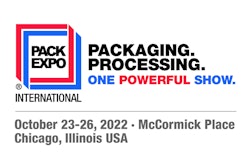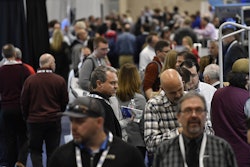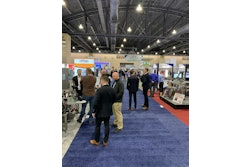Most PACK EXPO Forum sessions involve discussions on trends or issues that need addressing in the packaging and processing industry. Each day, as a bonus to attendees, Sean Riley sits down with two of our esteemed editors from PMMI Media Group to talk about real solutions from the show floor that attendees can stop by and take a look at. Since everyone can’t get to every booth, Matt Reynolds from Packaging World Magazine and Stephanie Neil from OEM share some must-see technologies that every attendee and exhibitor should be aware of.
To subscribe, rate, review and find more unPACKED podcast episodes, visit pmmi.org/podcast or find us on Apple podcasts, Spotify or iHeart Radio.
 | Read the full transcript below. |
Sean Riley:
Matt, you've been out there for a couple of hours. What have you seen so far at PACK EXPO East?
Matt Reynolds:
Yeah, well, three hours isn't a whole of lot of time to get a real pulse of the show. But one thing that we knew that was occurring even prior to the show was sustainability is on every brand's brain basically. They're working towards goals of 2025 or 2030 to make these... They made these goals for sustainability claims. So they need materials that are going to be more recyclable. So a lot of folks on the show floor are demonstrating new materials, films that are monolayer as opposed to their predecessors, which might have been multilayer laminates. Because they're more easily recyclable. One I saw out there is Zacros. I think I'm pronouncing that the right.. I might not be pronouncing it correctly, but basically they're going from what used to be a multilayer laminate structure to a monolayer PE polyethylene. I think it's low density stuff that they worked on in Japan with Procter & Gamble. And the brand is Pantene. We all know the hair care brand.
Matt Reynolds:
So this is a refill pouch that they're actually demonstrating. So it would be a durable, reusable package that they're using over and over again. And then the pouch itself with spout is refillable, or it uses a refill pouch. And again that can be recycled more easily because it's all polyethylene, it's all one material. Even the spout itself can be placed with high density stuff. So it's going into the same recycling stream. So a lot of people are struggling with sustainability, a lot of new films are out there. There's other materials too, Veritiv is working out... We all know of, like let's say, HelloFresh or Blue Apron, these meal kits. They've had trouble because there's a lot of packaging that's involved and consumers recognize that. So Veritiv has actually put together... The company that they're working with is called StorePAK and they have starch insulated panels.
Matt Reynolds:
So these panels are designed to go inside the corrugated case and with the assistance of a refrigerant. So some sort of a cooler or something like that, like an ice cooler, be able to maintain the cold chain for food in these kinds of meal kit situations. So again a lot of new materials on the show floor worth checking out.
Sean Riley:
And I know that's a huge issue with the meal kits. Everybody was... Especially during the pandemic or the height of the pandemic, everybody was doing a lot of cooking at home. And everybody was embracing the... Like you said, the HelloFresh as I don't want to leave out any of the brand names. But as you also added, everything comes in its own individual package. So it was literally five times as much trash, for lack of a better word, as you would have after regularly cooking a meal. And I know that that was something that was an issue. So I'm sure there's going to be people here looking for those types of solutions. Now, Steph you're a little more machinery based with OEM Magazine. So what have you seen out there from a machine standpoint?
Stephanie Neil:
Well, I like to tackle the show like I tackle the grocery store and go on the outer aisles first, which is exactly what I did. And I found this startup called Tudor Intelligence, and they are a bunch of MIT researchers who were trying to solve a problem around pick and place. And they were studying robot intelligence and they have developed some vision software that can work with cobots and with any gripper. And there's no programming needed. It's very much a drag and drop menu type of thing. And the interesting thing here is not only can it work with different materials, they're showing some candies, different shapes and sizes and picking and placing it, but you can start it up in minutes. He says it's just as easy as starting up a printer, but they're also going to rent these out.
Stephanie Neil:
So it's going to solve of a workforce problem if you don't have people on the line and you want to get a robot in there quickly, you can bring it in. And within a couple of minutes, have it going, you can programming it. And it's an intelligence that keeps learning as you teach it, but it's really supposed to, more than anything, solve a workforce problem.
Sean Riley:
So we're going to be positive and not say someone got sick, but say, "Bob's going on vacation for a week. I can bring this tutor robot in and fill Bob's role while he's sunning."
Stephanie Neil:
Yeah. Because ultimately, even though it is vision software and it is a robot they're calling themselves a robot staffing agency. So they have pilot projects. Now they're here to find some new customers and it's really a dynamic company so I'd encourage everybody to go take a look. The other company that I stumbled across was ONExia and they're based right here in Pennsylvania. They're a machine builder and a systems integrator. And in 2021, they started a robot division. And you know them, [Sean 00:05:47].
Sean Riley:
Yes.
Stephanie Neil:
You've talked to them. You've written about them, but they came out with a cobot palletizer, which is for heavy lifting. So it can lift up to 38 pound packages. And again, I'm told this is to solve a workforce issue. Because you want to take people off those mundane tasks that can be dangerous because if you're lifting heavy packages... And again it's easy to set up and use. So that seems to be a theme, being able to set these robots up really quickly. And those are the two main robot things that I saw that would really pique my interest.
Sean Riley:
The thing that gets lost with... We people in the industry know this, but in the mainstream is that the robots are here to replace people and put them out of work versus what you just explained. The robot's actually coming in and it's taking the place of doing jobs that people don't want to be involved with doing that are dangerous, that are dirty. That is like you said, mundane, repetitive things that they're going to end up quitting because they don't want to do the same thing over and over again. So they can moved up to do a position that uses their talents better. And you can use that cobot, something like that to lift the 38 pound box or whatever repetitively. So that's awesome because it is constantly a workforce issue in our industry. Matt, anything you've seen out there on the robot-
Matt Reynolds:
Yeah, I echo exactly what she's saying. What used to be the space of the cobot was extremely slow and low payload. And we're seeing those limitations erode and it's moving up into the higher payloads, higher speeds. Now of course they're still collaborative. So if a person were to enter into the space, they would immediately slow down or stop. But you're seeing what are considered collaborative robots that are much higher speed, much higher payload than they were before or smaller. They're just pushing on the edges of what used to be the limitations of the collaborative. I think Columbia/Okura is showing their miniPAL for instance. So moving smaller, moving larger, moving faster, just pushing... The lines are blurring between traditional robotics and collaborative robotics.
Stephanie Neil:
Well, I agree and the ONExia one... When I think of a collaborative robot, I think of a tiny, little desk robot, that's picking and placing. This is a giant arm that has an extended reach. So to your point, they're getting bigger. They can do more, there's more applications and they're easier to use and they're safer.
Matt Reynolds:
Yeah. They can operate with the teach pendants and so on. So it's almost you can... It's to the point where somebody with no training whatsoever can get these up and running pretty quickly.
Sean Riley:
See when I think of a collaborative robot, the first thing that comes to mind is the Roomba vacuums and how they go around your house. That's the smaller application I'm thinking of. Eventually it figures out not to run into me. But now like you're saying Steph, you're talking about a big thing, that's lifting 38 pounds. I keep saying that and I hope that's a number you said.
Stephanie Neil:
It is.
Sean Riley:
Otherwise I'm repeating the wrong number over and over again. But hopefully that was it. But clearly they're getting into bigger applications that can then again take these things away from people that shouldn't be doing that sort of thing over and over again.
Stephanie Neil:
Yeah.
Matt Reynolds:
Nobody should be lifting 38 pounds over and over again-
Sean Riley:
Exactly, unless you're a weight lifter. Yeah. We'll allow that for them.
Stephanie Neil:
Right. And I do... this issue of robots taking away jobs from people. I think we've talked about it over and over and it's just not the case. People are now elevated to do better jobs. They can be programming the robot or the supervisor of a fleet of robots, which is a much better job than lifting boxes.
Sean Riley:
I love it. And those are two, three, four great examples of things that people can see out here now. We have some people that are here listening to us in the audience. Any questions you might have for either Matt or Stephanie about anything that they've seen, whether on the show floor or through their coverage of the industry?
Matt Reynolds:
And remember it's only been three hours. So...
Speaker 4:
So I'd love to hear... You talked about the re skilling aspect of the robotics. How have you seen people address this now? Because the skillset for the immensely repeatable task versus what you had mentioned as the programming, the immensely repeatable task is drastically different. So have you seen people be able to transition those workers from on one task to the other?
Stephanie Neil:
I would weigh in by saying that, especially with the pandemic, people left their jobs and they're trying to find a new job. So they're not going to want to go to a warehouse or to a factory floor and pick and place something, but they might want to be a robot engineer. So it's about maybe the messaging and something that we've been trying to do with this industry for a long time, which is to change the image of manufacturing. It is no longer a dark and dirty and dangerous place to work. It's a great place to work. So with that, the next generation as well, the digital natives, they grew up on their iPads and their phones and playing the games. So they want a job where they're interacting with a computer screen versus an assembly line.
Matt Reynolds:
Yeah. And I would say, you're right. It can be considered a double-edged sword because the job that you're replacing, it requires a whole lot more training in a lot of cases. But I think companies in general are making the shift from... They're no longer hiring and training operators, they're hiring and training technicians. So it's like the mental shift between operator and technician is what's happening right now. And there's a lot more hours of training that go into it but it's a double-edged sword, like you said.
Sean Riley:
And I think to piggyback off that it was the first thing I thought of and Steph touched on it a bit. But when we had a similar discussion like this at PACK EXPO Las Vegas in the fall, we were talking a lot about automation. And a lot of the things that our editors were discovering was that the machinists, the OEMs that are making the machines or designing the machines are incorporating more of a interactive, similar to a tablet type interface. So that it's not that difficult to teach someone how to get up and running on a robot or get someone up and running on automation that, five, 10 years ago, would've been much more difficult to explain. So I think that is something that, making the machine easier to use and more user friendly is something that I think we've all seen.
Stephanie Neil:
Yeah. And I was sitting in on the forum session with Steph and Gerard on the great resignation. And it's one of the things that came up in that conversation from the audience members was, how do we manage all these different generations, but also how do we carve out a career path for them. That's really important. It's valuable to this next generation of the workforce. And I think these higher level types of jobs gives them a better path or they can see where they could be going and elevate their skillset versus working on an assembly line. So...
Sean Riley:
Thank you very much for taking time to sit in with us for this Daily Download. Matt I want to thank you for taking time to sit down with me and Stephanie as well-





















